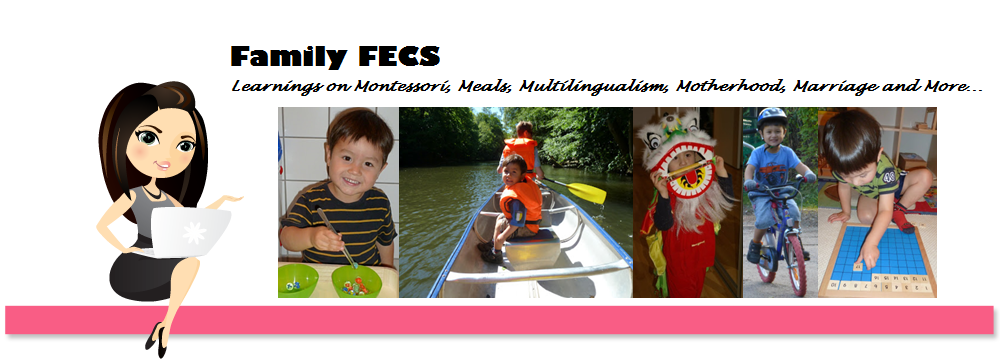AGE: 3.5 - 5 years old
ACTIVITY DURATION: 15 minutes
OBJECTIVE(S):
1. To learn to count each number by a single object as a whole separate from others and understand the value of each number (i.e. that each number represents a quantity and distinct
2. To teach the names of one to ten in relation to quantities.
MATERIALS:
1. The Number Rods
2. 2 mats or trays
PRESENTATION:
Day 1: Name the Number Rods
1. Ask your child to spread out a floor mat.
2. Name the Number Rods, show where they are kept and have your child go and fetch them.
3. Have your child arrange the rods into starting with the red section first, from the smallest to the longest (as seen from picture above).
4. When the child is able to arrange the rods in stair formation, isolate the first three rods and teach the Three Period Lesson.
5. Put Rod 1 in front of the child and say its name several times: “This is one.” Touch the rod and count: “one”. Put aside Rod 1. Put Rod 2 in front of the child and say: “This is two.” Point and touch each section and count: “One, two.” Put aside Rod 2. Do the same for Rod 3. (Period 1)
6. Place the three rods in front of the child in mixed order and ask: “Can you give me Rod 1?” then Rod 3 and then Rod 2. Repeat until the child knows the rods by name. (Period 2).
7. Put a rod in front of the child and ask: “What rod is this? Can you count it for me?” Do the same for all three rods (Period 3).
8. Always end your lesson by placing the rods in order.
9. Do the same with Rod 4 – 10 three rods at a time. Depending on the child, teach this in a day or over a few days.
Day 2: Name & Count
1. Mix the Number Rods on the mat.
2. Ask the child for a specific rod and place it on an empty mat.
3. Let the child count the alternating color segment of each rod one-by-one by touching each partition of the rod hand-over-hand (this will help fix the repeated numbers in his mind and helps him associate the spoken number with the concrete quantity of segments.)
4. If he forgets some of them, repeat the Three Period Lessons.
Day 3: Identify Quantity
1. Mix the Number Rods on the mat.
2. Pick a rod and place it in front of the child, ask: “What is this?”
3. Let the child count it and tell you the name of the rod. Then put aside the rod.
4. Do the same for all the rods.
Day 3: Identify Rod in Order
1. Lay out the Number Rods in stair formation order on the mat.
2. Point to a rod in stair formation and ask the child to say the name of the rod.
3. Let him verify by counting it.
4. Do the same for all the rods.
Day 4: Identify Rod Randomly
1. Mix the Number Rods on the mat.
2. Let the child pick a rod, place it on an empty mat, and say its name.
3. Let him verify by counting it.
4. Do the same for all the rods.
VIDEO DEMONSTRATION:
http://www.youtube.com/watch?v=-sbZScRMS4w
CONTROL OF ERROR:
Color and irregular progression of length.
ADDITIONAL INFORMATION:
Our Number Rods arrived today from Absorbent Minds Montessori. It was a very small set, but I do not mind it, as we have limited space at home. However, I was a little disappointed that the red and blue colors were not as bright as the pictures shown from their website, but it does the job.
But J did enjoy it, so I could live with it. I made the Number Rods using lego bricks, but that did not quite work with Joshua, as he kept taking them apart. Joshua (3Y7M21D) tried this set of small, but real Number Rods this evening, and it was the first time we managed to go through the whole activity as it meant to be with the Number Rods, so I was glad. It was just at the right challenge for him. He made some errors using visual judgment of the length. He had to count the partitions to get the size right.
REFERENCES:
http://www.infomontessori.com/mathematics/numbers-through-ten-number-rods.htm
http://web.archive.org/web/20050212085156/http://www.ux1.eiu.edu/~cfsjy/mts/math/_link.htm
http://www.moteaco.com/albums/casa/casamath.html#anchor2979127
Basic Montessori Learning Activities for Under-Fives
10 November 2019 (3Y5M24D): I tried this with C for the first time together. She was not using it as it was intended. She put them together, she made the shape rabbit, that only she can recognize. Finally, I use Montessori mystery bag and she finally use it as what it was intended for, by picking out a rod in the bag and saying its number.
10 November 2019 (3Y5M24D)


